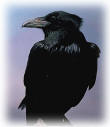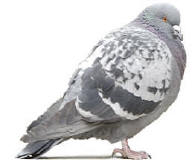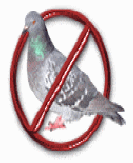|

Height/Weight
18"-21"
15oz-22oz
Life Span
6-7 years in the
wild; up to 20 captivity
Flight Speed
25-32 mph
Range
Continental U.S. Suburban/ Rural areas near water
Food
Scavenger, eats almost anything: insects, snakes, dead animals,
human food scraps, eggs and garbage
Habitat
Tall trees and buildings 20 to 100 feet up
|
|
|
Pigeon
Sparrow Swallow
Starling
Woodpecker Crow
Grackles
Crows Biology
and Control Information
There are two main species of
Crows, the large common crow found across the country and the smaller fish
crow found in the Southeast. The Common Crow is a big black colored bird
approximately 17 to 20 inches long with a strong stout build and a
compressed bill. The Fishing Crow is a smaller darker version of the
Common Crow. Both have a scavenger's diet and will eat a wide variety of
things. Such food items include insects, frogs, small snakes, eggs, mice
and dead animal carcasses. Crows will also eat newly planted crops such as
corn. Crows are well known for their intelligence. They are social birds
and the flock is in constant communication making hunting or capture of
the bird very difficult. The Crow's native history along with its helpful
bug eating habits have insured its Federally protected status.
The Crow is black from bill to tip of wing and claws with a metallic
violet gloss on body and a blue-violet/green-blue gloss on wings. Adults
have black eyes while juveniles have blue eyes.
Damage
Crows are frequently a big agricultural pest bird due to their fondness
for corn and other farm crops, but they are a minor urban pest compared to
the pigeon, starling or house sparrow. These birds can overwhelm trees,
creating a lot of noise and harassing people and animals in the vicinity
which can be a nuisance to the suburban resident. Furthermore, like any
pest bird, dropping buildup can lead to structural damage from the uric
acid while also posing a health risk due to the harborage of disease.
Nesting
Crows are committed nest builders. They typically build nests in trees,
twenty to sixty feet off the ground. The nest consists of sticks and twigs
with shredded bark, grass or a similar material lining it.
Breeding
Crows have one or two broods a year, averaging four to seven eggs per
brood. Incubation takes eighteen days with a four to five week fledgling
period before the young leave the nest. The eggs range from pale
bluish-green to olive green or greenish-brown with splotches of brown and
olive-gray.
Cycles
Migratory in upper parts of the country. Northern birds will fly thousands
of miles south during the winter, while southern birds stay put year
round. One notable characteristic about Crows is their flocking behavior.
In fall and winter they will move to better feeding areas where they will
coalesce into massive feeding flocks. These feeding flocks in turn, join
up with other flocks at night to form enormous communal roosts numbering
from a couple thousand to tens of thousands.
Control
It is possible to drive away large flocks of Crows and other blackbirds
with audio/visual scare devices such as the Bird-Gard unit combined with
visual scare devices like Scare Eye Balloons, Octopus and Flash Tape. To
maximize effectiveness, hang visual products in trees before commencing
noise campaign. They can be kept off ledges using 5” Bird Coil, Birdwire,
Bird-Flite spikes or Bird-Shock electrical track. Two inch mesh StealthNet
will exclude crows completely from most areas. Advanced predator kites
like the Avikite and fogging with ReJeX-iT are new effective deterrent
methods that can be effective against crows.
|
|
|




